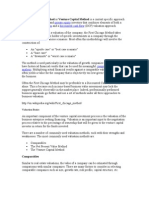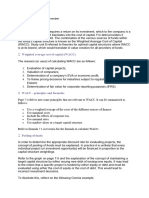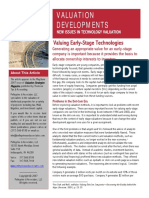Building Pro-Forma Financial Statements Comparables Net Present Value Method The Venture Capital Method
Building Pro-Forma Financial Statements Comparables Net Present Value Method The Venture Capital Method
Uploaded by
Karya BangunanCopyright:
Available Formats
Building Pro-Forma Financial Statements Comparables Net Present Value Method The Venture Capital Method
Building Pro-Forma Financial Statements Comparables Net Present Value Method The Venture Capital Method
Uploaded by
Karya BangunanOriginal Title
Copyright
Available Formats
Share this document
Did you find this document useful?
Is this content inappropriate?
Copyright:
Available Formats
Building Pro-Forma Financial Statements Comparables Net Present Value Method The Venture Capital Method
Building Pro-Forma Financial Statements Comparables Net Present Value Method The Venture Capital Method
Uploaded by
Karya BangunanCopyright:
Available Formats
Module 3: The Venture Capital Negotiation and Investment Process Valuations
Module 3: The Venture Capital Negotiation and Investment Process
Valuations
TABLE OF CONTENTS
1.0 BUILDING PRO-FORMA FINANCIAL STATEMENTS
1.01 Introduction
1.02 Comparables
1.03 Net Present Value Method
1.04 The Venture Capital Method
file:///P|/TME Diploma/TME courses/online_courseware/FIN320_content(tme3113)/Valuations/valuations-01.htm [09/26/2001 11:52:59 AM]
Module 3: The Venture Capital Negotiation and Investment Process The Venture Capital Investment Process
1.0 Valuations
1. 01 Introduction
An important component of the venture capital investment process is the valuation of the business enterprise seeking financing. Valuation is an
important input to the negotiation process relative to the percentage of ownership that will be given to the venture capital investor in return for the
funds invested.
There are a number of commonly used valuation methods, each with their strengths and weaknesses. A brief summary of the commonly used
methods will be provided below. A more detailed description is available in the assigned readings for this section. The most commonly used
valuation methods are:
1. Comparables
2. The Net Present Value Method
3. The Venture Capital Method
Note: See assigned readings “A Note on Valuation in Private Equity Settings,” HBS 9-297-050 for these and other methods.
file:///P|/TME Diploma/TME courses/online_courseware/FIN320_content(tme3113)/Valuations/valuations-02.htm [09/26/2001 11:53:00 AM]
Module 3: The Venture Capital Negotiation and Investment Process The Venture Capital Investment Process
1.02 Comparables
Similar to real estate valuations, the value of a company can be estimated through comparisons with similar companies. There are many factors to
consider in selecting comparable companies such as size, growth rate, risk profile, capital structure, etc.
Hence great caution must be exercised when using this method to avoid an “apples and oranges” comparison. Another important consideration is
that it may be difficult to get data for comparable companies unless the comparable is a public company. Another caveat when comparing a public
company with a private company is that, all other things being equal, the public company is likely to enjoy a higher valuation because of its
greater liquidity due to being publicly traded.
Refer to the example provided in Appendix 1, page 14 of the assigned reading “A Note on Valuation in Private Equity Settings.”
file:///P|/TME Diploma/TME courses/online_courseware/FIN320_content(tme3113)/Valuations/valuations-03.htm [09/26/2001 11:53:01 AM]
Module 3: The Venture Capital Negotiation and Investment Process The Venture Capital Investment Process
1.03 Net Present Value Method
The Net Present Value Method involves calculating the net present value of the projected cash flows expected to be generated by a business over a
specified time horizon or study period and the estimation of the net present value of a terminal value of the company at the end of the study
period. Note: See assigned reading “A Note on Free Cash Flow Valuation Models,” HBS 9-288- 023 for an in-depth description of this
method.
The net present value of the projected cash flows is calculated using the Weighted Average Cost of Capital (WACC) of the firm at its optimal
capital structure. Note: See Module 1 for a review of the Theory of Optimal Capital Structure, the cost of debt, the cost of equity, and
WACC.
Step 1: Calculate Net Present Value of Annual Cash Flows
Cash Flow for each future period in the time horizon or study period of the analysis is defined as follows:
CFn = EBITn*(1-t) + DEPRn – CAPEXn – .CNWCn
Where:
CF = cash flow or “free cash flow”
n = the specified future time period in the study period
EBITn = earnings before interest and taxes
t = the corporate tax rate
DEPRn = depreciation expenses for the period
CAPEXn = capital expenditures for the period
.NWCn = increase in net working capital for the period
It should be noted that interest expense is factored out of the cash flow formula by using EBIT (earnings before interest and taxes). This is because
the discount rate that is used to find the net present value of the cash flows is the WACC. The WACC uses the after tax cost of debt, which takes
into account the tax shields that result from the tax deductibility of interest. By using EBIT in the cash flow calculation, double counting of the tax
shields is avoided.
Step 2: Calculate the Net Present Value of the Terminal Value
The terminal value is normally calculated by what is often referred to as “the perpetuity method.” This method assumes a growth rate “g” of a
perpetual series of cash flows beyond the end of the study period. The formula for calculating the terminal value of the company at the end of the
study period is:
TVt = [CFt*(1 + g)]/(r – g)
Where:
TVt = the terminal value at time period t, i.e. the end of the study period
CFt = the projected cash flow in period t
g = the estimated future growth rate of the cash flows beyond t
Refer to the example provided in Appendix 2, page 15 of the assigned reading “A Note on Valuation in Private Equity Settings.”
file:///P|/TME Diploma/TME courses/online_courseware/FIN320_content(tme3113)/Valuations/valuations-04.htm [09/26/2001 11:53:01 AM]
Module 3: The Venture Capital Negotiation and Investment Process The Venture Capital Investment Process
1.04 The Venture Capital Method
Most venture capital investment scenarios involve investment in an early stage company that is showing great promise, but typically does not have
a long track record and its earnings prospects are perhaps volatile and highly uncertain. The initial years following the venture capital investment
could well involve projected losses.
The venture capital method of valuation recognizes these realities and focuses on the projected value of the company at the planned exit date of
the venture capitalist.
The steps involved in a typical valuation analysis involving the venture capital method follow.
Step 1: Estimate the Terminal Value
The terminal value of the company is estimated at a specified future point in time. That future point in time is the planned exit date of the venture
capital investor, typically 4-7 years after the investment is made in the company.
The terminal value is normally estimated by using a multiple such as a price-earnings ratio applied to the projected net income of the company in
the projected exit year.
In the example provided in Appendix 4, page 19 of the assigned reading “A Note on Valuation in Private Equity Settings,” a price-earnings
ratio of 15 is applied to the projected net income of $20 million in the planned exit year, year 7. This yields a projected exit value of $300 million
in year 7. The choice of multiple for the valuation is something that will be a matter of discussion during the venture capital negotiations. PE ratios
for comparable public companies will be used as a benchmark to select a PE for the company, recognizing that PE ratios for public companies are
likely to be higher due to their greater liquidity relative to a private company.
Step 2: Discount the Terminal Value to Present Value
In the net present value method, the firm’s weighted average cost of capital (WACC) is used to calculate the net present value of annual cash
flows and the terminal value.
In the venture capital method, the venture capital investor uses the target rate of return to calculate the present value of the projected terminal
value. The target rate of return is typically very high (30-70%) in relation to conventional financing alternatives. For a detailed understanding of
why venture capital target rates of return are so high, see assigned readings “How Venture Capital Works” and “A Method for Valuing
High-Risk, Long-Term Investments”.
In the example provided in Appendix 4, page 19 of the assigned reading “A Note on Valuation in Private Equity Settings,” the projected
terminal value in year 7 of $300 million is discounted to a present value of $17.5 million using a target rate of return of 50%.
PV = FV/(1+I)n = $300m/(1+.50)7 = $17.5 million
Step 3: Calculate the Required Ownership Percentage
The required ownership percentage to meet the target rate of return is the amount to be invested by the venture capitalist divided by the present
value of the terminal value of the company. In this example, $5 million is being invested. Dividing by the $17.5 million present value of the
terminal value yields a required ownership percentage of 28.5%.
The venture capital investment can be translated into a price per share as follows.
The company currently has 500,000 shares outstanding, which are owned by the current owners. If the venture capitalist will own 28.5% of the
shares after the investment (i.e. 71.5% owned by the existing owners), the total number of shares outstanding after the investment will be
500,000/0.715 = 700,000 shares. Therefore the venture capitalist will own 200,000 of the 700,000 shares.
Since the venture capitalist is investing $5.0 million to acquire 200,000 shares the price per share is $5.0/200,000 or $25 per share.
Under these assumptions the pre-investment or pre-money valuation is 500,000 shares x $25 per share or $12.5 million and the post-investment
or post-money valuation is 700,000 shares x $25 per share or $17.5 million.
Step 4: Calculate Required Current Ownership % Given Expected Dilution due to Future Share Issues
The calculation in Step 3 assumes that no additional shares will be issued to other parties before the exit of venture capitalist. Many venture
companies experience multiple rounds of financing and shares are also often issued to key managers as a means of building an effective,
motivated management team. The venture capitalist will often factor future share issues into the investment analysis. Given a projected terminal
value at exit and the target rate of return, the venture capitalist must increase the ownership percentage going into the deal in order to compensate
for the expected dilution of equity in the future.
The required current ownership percentage given expected dilution is calculated as follows:
file:///P|/TME Diploma/TME courses/online_coursew...320_content(tme3113)/Valuations/valuations-05.htm (1 of 2) [09/26/2001 11:53:01 AM]
Module 3: The Venture Capital Negotiation and Investment Process The Venture Capital Investment Process
Required Current Ownership = Required Final Ownership divided by the Retention Ratio
In the example in Appendix 4, shares amounting to 10% of the equity are expected to be sold to managers and shares equivalent to 30% of the
common stock will be sold to the public in an IPO.
In this case the Retention Ratio is [1/(1+0.1)/(1+0.3)] = 70%
Therefore, Required Current Ownership = 28.5%/70% = 40.7%
In other words, in order to preserve a 28.5% final ownership percentage at exit, the venture capitalist must get a 40.7% ownership interest going
into the deal, given the expected future dilution.
The number of new shares that will have to be issued at the outset will therefore have to be 500,000/(1-40.7%) – 500,000 = 343,373
The price per share will therefore be $5 million/343,373 = $14.56 per share.
Open the Excel spreadsheet Venture Capital Method. The example provided on the spreadsheet is the example provided in Appendix 4, page 19
of the assigned reading “A Note on Valuation in Private Equity Settings.” You may clear the values in the cells shaded yellow and use the
spreadsheet for other Venture Capital Method valuations.
file:///P|/TME Diploma/TME courses/online_coursew...320_content(tme3113)/Valuations/valuations-05.htm (2 of 2) [09/26/2001 11:53:01 AM]
You might also like
- Investment Appraisal Report (Individual Report)Document10 pagesInvestment Appraisal Report (Individual Report)Eric AwinoNo ratings yet
- Equity Valuation GsDocument76 pagesEquity Valuation GsKarya BangunanNo ratings yet
- Valuing Real Assets in The Presence of Risk: Strategic Financial ManagementDocument15 pagesValuing Real Assets in The Presence of Risk: Strategic Financial ManagementAnish Mittal100% (2)
- Answers - Cost of Capital Wallmart Inc.Document11 pagesAnswers - Cost of Capital Wallmart Inc.Arslan HafeezNo ratings yet
- Nike Case Study-ResponseDocument8 pagesNike Case Study-ResponseAnurag Sukhija100% (5)
- Swot Analsis For Toys R Us PunitaDocument6 pagesSwot Analsis For Toys R Us PunitaKalpesh PanchalNo ratings yet
- Goliath Transfer Pricing Case ArticleDocument13 pagesGoliath Transfer Pricing Case ArticleFridRachmanNo ratings yet
- Venture Capital Private Equity Multiples-Based Valuation Discounted Cash FlowDocument7 pagesVenture Capital Private Equity Multiples-Based Valuation Discounted Cash FlowSarah DetoitoNo ratings yet
- CFINDocument10 pagesCFINAnuj AgarwalNo ratings yet
- Valuation Wha You Need To KnowDocument3 pagesValuation Wha You Need To KnowVarenka RodriguezNo ratings yet
- Af208 Fe s1 2018 Revision Package - SolutionsDocument20 pagesAf208 Fe s1 2018 Revision Package - SolutionsAryan KalyanNo ratings yet
- VCMethod PDFDocument10 pagesVCMethod PDFMichel KropfNo ratings yet
- Lecturenote - 1762467632financial Management-Chapter ThreeDocument22 pagesLecturenote - 1762467632financial Management-Chapter ThreeJOHNNo ratings yet
- Cost of Capital - NumericalDocument18 pagesCost of Capital - Numericalnaina kishnaniNo ratings yet
- 114 Financial ManagementDocument8 pages114 Financial ManagementMayukh RoyNo ratings yet
- Chapter 10: Common Stock ValuationDocument24 pagesChapter 10: Common Stock ValuationLee ShaykhNo ratings yet
- EET455 - M5 Ktunotes - inDocument41 pagesEET455 - M5 Ktunotes - inrajkumarNo ratings yet
- Answers For Corporate Finance AssignmentDocument7 pagesAnswers For Corporate Finance AssignmentBhupesh Vrat AryaNo ratings yet
- Edited by Thomy 1@PFC 3Document44 pagesEdited by Thomy 1@PFC 3Thomas TashomaNo ratings yet
- Mco-07 Solved Assignment 2017-18Document12 pagesMco-07 Solved Assignment 2017-18AjayNo ratings yet
- Unit 2nd Financial Management BBA 4thDocument14 pagesUnit 2nd Financial Management BBA 4thnikitagaur55No ratings yet
- Chapter 2 - CompleteDocument29 pagesChapter 2 - Completemohsin razaNo ratings yet
- Accounting and Finance For Decision MakingDocument10 pagesAccounting and Finance For Decision Makingswati raghuvansiNo ratings yet
- Capital Budgeting and Cost AnalysisDocument4 pagesCapital Budgeting and Cost Analysishxn1421No ratings yet
- Gitman 12e 525314 IM ch11r 2Document25 pagesGitman 12e 525314 IM ch11r 2jasminroxas87% (15)
- Gitman 12e 525314 IM ch11rDocument22 pagesGitman 12e 525314 IM ch11rAnn!3100% (1)
- Chapter 8 AnswersDocument3 pagesChapter 8 AnswersayaNo ratings yet
- Analysis and Interpretation of Financial StatementsDocument25 pagesAnalysis and Interpretation of Financial StatementsAnim SaniNo ratings yet
- Goldfarb2010 Insruance PDFDocument50 pagesGoldfarb2010 Insruance PDFK RajeshwaranNo ratings yet
- Financial MGMTDocument11 pagesFinancial MGMTSujit KumarNo ratings yet
- AssigmentDocument19 pagesAssigmentTân NguyênNo ratings yet
- IPM - Written Report - TinioDocument8 pagesIPM - Written Report - Tiniogilbertson tinioNo ratings yet
- CH 07Document31 pagesCH 07mohhomNo ratings yet
- Master of Business Administration-MBA Semester 2 MB0045 - Financial Management - 4 Credits (Book ID: B1134) Assignment Set - 2 (60 Marks)Document13 pagesMaster of Business Administration-MBA Semester 2 MB0045 - Financial Management - 4 Credits (Book ID: B1134) Assignment Set - 2 (60 Marks)Maulik Parekh100% (1)
- Assessing Financial Health (Part-A)Document17 pagesAssessing Financial Health (Part-A)kohacNo ratings yet
- ACF Module 1 THEORY 29TH FebDocument10 pagesACF Module 1 THEORY 29TH FebRajesh KumarNo ratings yet
- Corporate Finance - Unit 3 NotesDocument6 pagesCorporate Finance - Unit 3 Notesfatimafirdaus147No ratings yet
- Cost of Capital SU9 - OverviewDocument5 pagesCost of Capital SU9 - Overviewkevgoat217No ratings yet
- Investment Center and Transfer PricingDocument10 pagesInvestment Center and Transfer Pricingrakib_0011No ratings yet
- Study System Session Topic Study Bank Date Completed 0 SyllabusDocument10 pagesStudy System Session Topic Study Bank Date Completed 0 SyllabusMadalina CiupercaNo ratings yet
- Financial Markets and InvestmentsDocument7 pagesFinancial Markets and InvestmentsLipika haldarNo ratings yet
- Financial Management I Sem 4Document60 pagesFinancial Management I Sem 4trashbin.dump123No ratings yet
- Cost of CapitalDocument8 pagesCost of Capitalpetut zipagangNo ratings yet
- MB0045 - Mba 2 SemDocument19 pagesMB0045 - Mba 2 SemacorneleoNo ratings yet
- Ratio AnalysisDocument9 pagesRatio AnalysisSushil RavalNo ratings yet
- GPF 1 Lec 2Document20 pagesGPF 1 Lec 2Habiba HishamNo ratings yet
- ACCT 504 MART Perfect EducationDocument69 pagesACCT 504 MART Perfect Educationdavidwarn1223No ratings yet
- Research On Stock Valuation of Listed Companies AnDocument10 pagesResearch On Stock Valuation of Listed Companies Anlapofaw861No ratings yet
- Evaluating Project Economics and Capital Rationing: Learning ObjectivesDocument53 pagesEvaluating Project Economics and Capital Rationing: Learning ObjectivesShoniqua JohnsonNo ratings yet
- Mba Corporate FinanceDocument13 pagesMba Corporate FinanceAbhishek chandegraNo ratings yet
- Finacial and Management AccountingDocument13 pagesFinacial and Management AccountingSaumya MathurNo ratings yet
- Answers MS 42Document13 pagesAnswers MS 42SHRIYA TEWARINo ratings yet
- Relaince IndustriesDocument30 pagesRelaince IndustriesAkshata MasurkarNo ratings yet
- LM06 Cost of Capital-Foundational TopicsDocument12 pagesLM06 Cost of Capital-Foundational TopicsSYED HAIDER ABBAS KAZMINo ratings yet
- The Validity of Company Valuation Using Discounted Cash Flow MethodsDocument25 pagesThe Validity of Company Valuation Using Discounted Cash Flow MethodsSoumya MishraNo ratings yet
- Business InnovationDocument13 pagesBusiness InnovationKim van RuitenNo ratings yet
- DCF PPTDocument16 pagesDCF PPTgagan8189No ratings yet
- Mercury Athletics Footwear Case: B52.FIN.448 Advanced Financial Management Professor Roni KisinDocument7 pagesMercury Athletics Footwear Case: B52.FIN.448 Advanced Financial Management Professor Roni KisinFaith AllenNo ratings yet
- Corporate Finance NotesDocument13 pagesCorporate Finance Noteshello2258100% (2)
- Bav Notes Unit 3rdDocument10 pagesBav Notes Unit 3rdMrSURYAA pandeyNo ratings yet
- Examination Paper 1Document11 pagesExamination Paper 1dechickeraNo ratings yet
- Merrill Lynch - Assessing Cost of Capital and Performance 2015Document16 pagesMerrill Lynch - Assessing Cost of Capital and Performance 2015CommodityNo ratings yet
- Applied Corporate Finance. What is a Company worth?From EverandApplied Corporate Finance. What is a Company worth?Rating: 3 out of 5 stars3/5 (2)
- Putting A Face To A (Screen) NameDocument34 pagesPutting A Face To A (Screen) NameKarya BangunanNo ratings yet
- Bafia FsaDocument7 pagesBafia FsaKarya BangunanNo ratings yet
- Static Capacity Plate GirderDocument10 pagesStatic Capacity Plate GirderKarya BangunanNo ratings yet
- Meausing A MoatDocument73 pagesMeausing A MoatjesprileNo ratings yet
- Concept Checks EVA DamodaranDocument2 pagesConcept Checks EVA DamodaranKarya BangunanNo ratings yet
- The Suharto OligarchyDocument24 pagesThe Suharto OligarchyKarya BangunanNo ratings yet
- Marginal Analysis Business CalculusDocument69 pagesMarginal Analysis Business CalculusKarya BangunanNo ratings yet
- Corporate Longevity CsDocument29 pagesCorporate Longevity CsKarya BangunanNo ratings yet
- CB Primer GsDocument141 pagesCB Primer GsKarya BangunanNo ratings yet
- Compounding and Annuity Tables Use in Equity ValuationDocument8 pagesCompounding and Annuity Tables Use in Equity ValuationKarya BangunanNo ratings yet
- Valuing Early Stage TechnologiesDocument20 pagesValuing Early Stage TechnologiesKarya Bangunan100% (1)
- The Return of The Bond Vigilantes: ObituaryDocument1 pageThe Return of The Bond Vigilantes: ObituaryKarya BangunanNo ratings yet
- Exercise 6 Create Drop Down List: (Combo Boxes For Customerid & Productno)Document4 pagesExercise 6 Create Drop Down List: (Combo Boxes For Customerid & Productno)Karya BangunanNo ratings yet
- Hertz AMC Chapter 11 FT 2021-01-26Document1 pageHertz AMC Chapter 11 FT 2021-01-26Karya BangunanNo ratings yet
- Class 23: Fixed Income, Interest Rate SwapsDocument21 pagesClass 23: Fixed Income, Interest Rate SwapsKarya BangunanNo ratings yet
- Ex 7Document2 pagesEx 7Karya BangunanNo ratings yet
- Transfer PricingDocument20 pagesTransfer PricingRia Gabs100% (1)
- HORNGREN 12-20 Target Operating Income, Value-Addedcosts, ServicecompanyDocument5 pagesHORNGREN 12-20 Target Operating Income, Value-Addedcosts, ServicecompanyLyka RoguelNo ratings yet
- Construction ContractsDocument25 pagesConstruction ContractsPaarth AgrawalNo ratings yet
- Microeconomics - Theory Through ApplicationsDocument828 pagesMicroeconomics - Theory Through ApplicationsRunal Bhanamgi100% (1)
- Alternative Center For Organizational Reforms and Development, Inc., vs. ZamoraDocument2 pagesAlternative Center For Organizational Reforms and Development, Inc., vs. ZamoraRiel BanggotNo ratings yet
- Impact of Agricultural Export On Economic Growth PDFDocument28 pagesImpact of Agricultural Export On Economic Growth PDFAKINYEMI ADISA KAMORUNo ratings yet
- MIDTERM 2 Ecn 301 Spring 2012Document2 pagesMIDTERM 2 Ecn 301 Spring 2012Zahra Ahmed AlfarajNo ratings yet
- I So LettersDocument3 pagesI So LettersTauheedAlamNo ratings yet
- Mar 2019 Paper 2A Questions EngDocument10 pagesMar 2019 Paper 2A Questions EngTerry MaNo ratings yet
- Chapter 9-STOCK VALUATION-FIXDocument33 pagesChapter 9-STOCK VALUATION-FIXRacing FirmanNo ratings yet
- MR's Aide Faces Money Laundering ChargesDocument5 pagesMR's Aide Faces Money Laundering ChargesThavam RatnaNo ratings yet
- Naeem Khan: AccountantDocument2 pagesNaeem Khan: AccountantAnonymous d8sGHfQNo ratings yet
- Advanced Financial AccountingDocument17 pagesAdvanced Financial Accountingtassnimemad12No ratings yet
- Pananaw 2020 PDFDocument93 pagesPananaw 2020 PDFKobi SaibenNo ratings yet
- Pricing Methods: Sujith Nair Musaliar Institute of ManagementDocument18 pagesPricing Methods: Sujith Nair Musaliar Institute of ManagementSujith NairNo ratings yet
- Salary Calculation Yearly & Monthly Break Up of Gross SalaryDocument1 pageSalary Calculation Yearly & Monthly Break Up of Gross SalaryANKIT_JAIN84No ratings yet
- 3FM AnswerDocument15 pages3FM AnswerRenzNo ratings yet
- Laura Ashley Holdings PLC Case SolutionDocument8 pagesLaura Ashley Holdings PLC Case SolutionSamarthNo ratings yet
- 5 PigovianTax2Document38 pages5 PigovianTax2api-3709940No ratings yet
- TQM PracticesDocument11 pagesTQM PracticesMelvin Dxb MyDubaiNo ratings yet
- Washington State Institute For Public PolicyDocument16 pagesWashington State Institute For Public PolicyWashington State Institute for Public PolicyNo ratings yet
- Internship Report General Banking JBLDocument49 pagesInternship Report General Banking JBLAvijit SahaNo ratings yet
- Questions NIDocument4 pagesQuestions NItyagi_rajat8918No ratings yet
- Project On SbiDocument50 pagesProject On SbiAshish Yadav100% (1)
- Chapter 2Document25 pagesChapter 2Abas Mohamed SidowNo ratings yet
- Topic:: Accounts of Holding CompaniesDocument19 pagesTopic:: Accounts of Holding CompaniesCharu LataNo ratings yet
- The Top 10 Risks For Oil and GasDocument24 pagesThe Top 10 Risks For Oil and GasMsm MannNo ratings yet
- Self-Learning Kit: Region I Schools Division of Ilocos Sur Bantay, Ilocos SurDocument13 pagesSelf-Learning Kit: Region I Schools Division of Ilocos Sur Bantay, Ilocos SurLiam Aleccis Obrero CabanitNo ratings yet










































































































